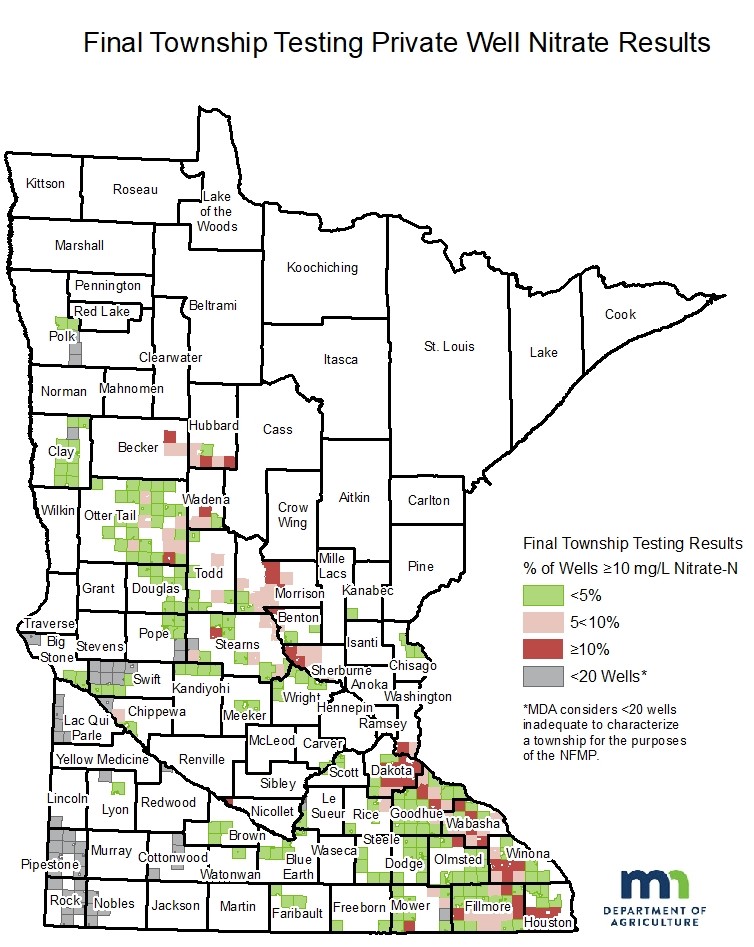The goal of mitigation is to reduce nitrate levels in groundwater. The key is to engage the local community in problem solving to develop solutions. Target groups include farmers, crop advisers, fertilizer retailers, and farm organizations.
Township Mitigation Level Determination Process
Under the Nitrogen Fertilizer Management Plan, the MDA determines mitigation levels for townships with elevated levels of nitrate-nitrogen in private wells. Level determination is based on results from the Township Testing Program and is used to prioritize and guide groundwater protection activities.
If 5-9.9% of the tested wells within a township exceed the nitrate concentration of 10 mg/L the township is designated Mitigation Level 1. Townships are designated Mitigation Level 2 if 10% or more of the tested wells exceed the 10 mg/L concentration.
Mitigation Level | Percentage of wells used for determination |
|---|---|
Level 1 | 5 to 9.9% of tested private wells exceeding 10 mg/L |
Level 2 | 10% or more of tested private wells exceeding 10 mg/L |
The map below shows the Township Testing Program’s final results from 2013 to 2019. These samples were collected by MDA staff and used to make the mitigation level determinations. The MDA has identified 60 Level 1 townships and 44 Level 2 townships.

Within high nitrate townships, the MDA will follow a step-wise process that is outlined in the Nitrogen Fertilizer Management Plan. The goal is to work with the agricultural community, problem solve at the local level, and increase adoption of practices that protect local groundwater.
Key steps in the process include forming a local team, surveying agricultural practices, water monitoring, computer modeling and publishing a list of management practices to protect groundwater and working with farmers and key partners to adopt practices.
Local Advisory Teams
In townships designated Mitigation Level 2, local advisory teams (LATs) will consist of local farmers, agronomists, conservation staff, and key partners that make or support nitrogen fertilizer use decisions. The role of the LAT is to advise and consult with the MDA.
Working with partners, the MDA publishes a list of best management practices (BMPs) that apply to cropland within the township and are protective of groundwater. Following the practices on the BMP list is strongly encouraged but is voluntary in townships.
Additional information for select townships can be found using the links within the table. Mitigation Level 2 townships are listed by county.
County | Mitigation Level 2 Townships |
|---|---|
Becker | Pine Point |
Benton | Langola |
Dakota | Nininger, Coates, Empire, Vermillion, Marshan, Ravenna, Castle Rock, Hampton, Douglas |
Fillmore | Arendahl, Norway, Bloomfield, Preble |
Goodhue | Vasa, Goodhue |
Houston | Black Hammer, Caledonia, Mayville, Spring Grove, Wilmington |
Hubbard | Hubbard and Badoura |
Morrison | |
Mower | Nevada |
Olmsted | Farmington |
Otter Tail | Parkers Prairie |
Sherburne | |
Stearns | Grove |
Wabasha | Mount Pleasant, West Albany, Hyde Park, Oakwood, Plainview |
Wadena | Wing River |
Washington | Oak Grove |

